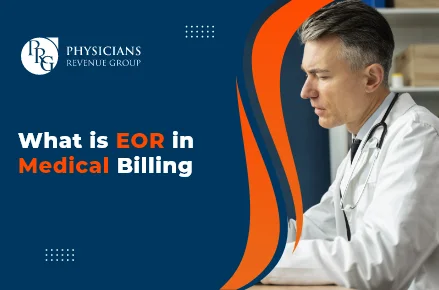
Email: info@prgmd.com | Call: +1 (630) 242-6474
Business hours: 9:00 to 5:00 | Monday to Friday
Email: info@prgmd.com | Call: +1 (630) 242-6474
Business hours: 9:00 to 5:00 | Monday to Friday

Table of Contents
ToggleThe medical billing process is a core step in a patient-doctor relationship. Medical billing services ensure payments for all services rendered go through. It also helps keep track of your accounts receivables and accounts payable. Successful physicians’ or medical biller earnings are appropriately based on the collected revenue. However, this is possible if the medical billing process is flawless.
The most crucial step is to retrieve patient information; these details include the name, residence, gender, and contact information of the patient. Plus insurance relating information is also essential and includes:
In this step, you will be asked to enter the patient’s insurance card details while entering a patient’s demographic information. Here you can also use other documentation that confirms their identity, such as a driver’s license or a passport. The demographic area and the insurance information must be carefully recorded and updated regularly if the patient visits the medical practice frequently.
This information is the foundation of a medical claim for rewarding healthcare practitioners. The errors or discrepancies between entered data and your company’s data can be addressed swiftly. When it is time to pay these bills, the errors will not affect your medical billing cycle.
Submission of clean claims is the first and most important step for a successful medical billing process. Successful claims submissions translate to boosted revenue for your medical practice, with a faster turnaround time for your patients. The entire claims submission process needs to be done timely, and accurately so your patients don’t end up paying out of their pockets or pay any penalties when there is nothing wrong with your patient’s insurance coverage.
All this means doing the process carefully from start to finish by following industry guidelines and using complaint templates. Also, keeping track of all documentation and being able to elaborate on why each element is vital while presenting any related questions regarding this part.
Payment processing is the procedure of receiving payment from patients. It can be done in two ways, offline or online—third parties who charge a fee and accept credit card payments over the web process online payments.
Multiple offline payment options include cashier’s checks or wire transfers. One might also have manual payment processing options if one prefers to use something different than the automated methods. The manual payments also let you set specific dates when the bills can be made due; this ensures that bills are never in arrears again.
Denial is a common occurrence and a problem in medical billing. When faced with denials, the first step is to understand why denials happen and how. Plus, what can be done to enhance your chances of getting paid? It is essential to know that each claim comes with a risk factor, but there are multiple ways to minimize this risk. If an insurance organization moves to deny your claims, it usually means of the below-mentioned things:
The primary purpose of the successful receivables management process is to collect money from your patients for services you have given them as a medical practitioner or a medical practice. Below are the critical steps for the receivables management process including:
The medical scripts are made to make their way to medical coders, and these coders convert your treatments, diagnosis, and other related data into standardized ICD-10 and CPT codes. The insurers can then use these codes to determine whether or not they shall reimburse the patients based on their health plans.
These codes also appear on medical claims along with the charges and patients’ demographic information. The procedure codes also describe a patient’s treatment strategy. To offer more detailed information about the process or the service, use CPT and HCPCS code modifiers. Only armed with relevant codes and modifiers can the insurance payer make up a proper evaluation.
Adjudication is a process via which payers elevate compliant and valid medical claims and the amount of reimbursement to the providers. These claims can move to be approved, rejected, or refused during the process. The insurers reimburse providers for acceptable claims under the agreements. The rejected claims contain errors to be rectified before the claim can be resubmitted. A refused claim is one where the payer declines to pay.
Patient statements are documents that carry all of the information in pertinence to a patient’s bill. This is sent to the patient after their medical bills have been processed and treated, so they can easily download and review it. This statement includes payment options, deductibles, copays, and more.
If some non-zero debt occurs from the submission of a claim for a patient without secondary insurance, one must offer them a statement describing their charges. One must also send out a benefits explanation to elaborate on what the patient gets and does not get via their insurance plans. This is how patients can understand why they owe you money despite having insurance.
The last step for improving efficiency in the medical billing process is to ensure that the bills get paid. Medical billers are responsible for mailing out the precise medical bills, that too on time, and then keep following up with the patients whose bills get past their due dates.
The data is saved inside a patient’s file after it is paid. Again, medical billers are responsible for ensuring that the providers are reimbursed appropriately in case of late or half payment. This might entail approaching the patients directly, sending out follow-up bills, or in the worst-case scenario, getting hold of the services of a collections agency.
In addition to the primary data you need to offer your clients, multiple other analytics, reports, and dashboards can be helpful in a medical billing lifecycle. These include but are not limited to the following:
a. Medical Bill Status
This status report shows the portion of a patient’s bill that the insurance companies or Medicare has paid. It also elaborates an estimate of what percentage of the remaining amount shall be covered by insurance coverage in every case.
b. Patient Satisfaction
The patient satisfaction dashboard offers your patients an overview of their customer experience with your medical practice, including satisfaction factors, communication, treatment options, scheduling, and more at the time of their visit. The lower half of this dashboard can be used to seek to advise on what could be made better for future patients.
The medical billing process can only become successful if it is flawless from the get-go. Your practice must perform all these processes meticulously, with proper documentation and customer care.
Does it sound too overwhelming? Let the Physicians Revenue Group help you with medical billing services. At PRG, we take the lion’s share of the legalities while letting you work on the patients exactly how it should be. Not only do our expert medical billers keep the entire revenue cycle management of your practice straightforward, but our medical auditing services also offer you multiple ways in which you can grow your revenue to new heights.
The most common reason for denied claims is incorrect information. Be it by accident or intentionally, coding and billing errors are the most common reasons for claims denials due to incomplete, missing, or incorrect information.
It is a strategic process that aims to resolve and unmask problems that lead to claim denials.
Share:
Categories
Recently Added

What is an ABN in medical billing?

What does a Clearinghouse do During Claims Submission?

What is EOR in Medical Billing?
We Would Love to Assist You!
We treat your data confidentially and don’t share any information with a third party.